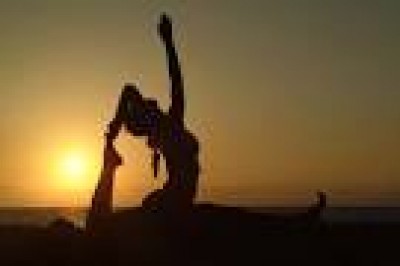New Yoga Classes in St. John
Our yoga experience on our small and beautiful island continues to grow with the addition of three new yoga classes.
- At Concordia, we now have Yin Yang Yoga on Sunday mornings at 7:30 with Heather .
- At the Recreation Center in Cruz Bay, we have Power Yoga on Saturday mornings at 9:00 with Lindsey.
- At Mongoose Junction in Cruz Bay, we have Yoga Exploration on Monday evenings at 5:30 – 7:00PM with Patricia and Andrew.
So let’s explore these new classes.
Yin Yang Yoga
Yin Yang Yoga is designed to offer the balancing effects of yin (passive) and yang (active) styles of yoga and allow you to reach deeper into your practice. This class draws upon the more internal, quiet and longer held postures, balanced with the more active, moving and dynamic or heat producing yoga postures to create a holistic body experience.
So what is the Yin? Yin Yoga is a slow-paced style of yoga with asanas that are held for comparatively long periods of time. It was founded and first taught in the US in the late 1970s by martial arts expert and Taoist yoga teacher Paulie Zink. Yin-style yoga is now being taught across North America and in Europe, due in large part to the teaching of Yin Yoga teachers Paul Grilley and Sarah Powers.
Yin Yoga poses apply moderate stress to the connective tissues—the tendons, fascia, and ligaments—with the aim of increasing circulation in the joints and improving flexibility. The practice of holding yoga poses or asanas for long periods of time has been part of traditional yoga practice, both in the Hatha yoga tradition of India and in the Taoist yoga tradition of the greater China area. Contemporary schools of hatha yoga have also advocated holding some poses for relatively long periods of time including BKS Iyengar.
And now for the Yang? We are more familiar with the Yang. The typical vinyasa flow bringing us a more active asanas practice. The Yang increases our flexibility and strength as we move through various asanas at quicker rate. This activity directs energy and flow into the muscles and superficial connective tissues.
And coming together of the two? From an article by Sarah Powers in 2001, she describes Yin Yang yoga as reaching deeper both mentally and physically into a very integrated and satisfying practice. The Yin part of the class comes first. This holding of the asanas before the muscles are warm allows energy and prana to reach the deeper connective tissues of the joints. Fluids have time to get to the joints and deep tissues allowing them to get “juicer” and stretch appropriately. Then it is time for the Yang. Once the muscles as well as the joints have awakened, the Yang brings in the more vigorous movements to build strength and challenge the body.
Power Yoga – Pushing your edges
Power yoga is a general term used in the West to describe a vigorous, fitness-based approach to vinyasa-style yoga and incorporates Ashtanga yoga. The term came into common usage in the mid 1990s, in an attempt to make Ashtanga yoga more accessible to western students. Its emphasis is on strength and flexibility.
For a brief view of the history behind Power Yoga, let’s explore its core: Ashtanga Yinyasa Yoga. Ashtanga is a style of yoga codified and popularized by K. Pattabhi Jois. Pattabhi Jois began his yoga studies in 1927 at the age of 12, and by 1948 had established an institute for teaching the specific yoga practice known as Ashtanga (“eight-limbed”) Vinyasa Yoga. The term vinyāsa refers to the alignment of movement and breath, a method which turns static asanas into a dynamic flow. The length of one inhale or one exhale dictates the length of time spent transitioning between asanas. Two American yoga teachers are most often credited with the invention of power yoga: Beryl Bender Birch, based in New York, and Bryan Kest, based in Los Angeles. Not coincidentally, both these teachers had studied with Pattabhi Jois. Using the term power yoga differentiated the intense, flowing style of yoga they were teaching from the gentle stretching and meditation that many Americans associated with yoga.
Power Yoga has been argued to be the fundamental style of Hatha yoga that allowed for cultural acceptance of yoga in North America. According to the North American Studio Alliance, 30 million people are practicing yoga in the US. This includes practitioners not just of Power Yoga, but the entire practice of Yoga. Power yoga has been thought of as a physically demanding practice, which can be successful at channeling the hyperactivity of active minds. This system can also be used as a vessel for helping calm ongoing chatter of the mind, reducing stress and teaching extroverted personalities to redirect their attention to their internal experience. Power Yoga will most likely appeal to people who are already quite fit, enjoy exercising, and want a minimal amount of chanting and meditation with their yoga. Prepare to work hard and work up a sweat.
Yoga Exploration
The Yoga Exploration classes offer an organic, internal and exploratory approach to access your core energy, release internal holding patterns, and help you feel balanced, energized and refreshed. Invited by the breath, imagery and guided movement, these gentle-yet powerful classes will focus on helping you create more space, fluidity, and ease of movement. Patricia and Andrew will explore Asana from the inside out, meditation and the breath,
occasionally partner poses, and restorative poses. There is usually a short
Free Form Chapter, where they put on a music playlist to help you pause, listen and practice together what you feel guided to do. Classes start on Monday, January 13th.




